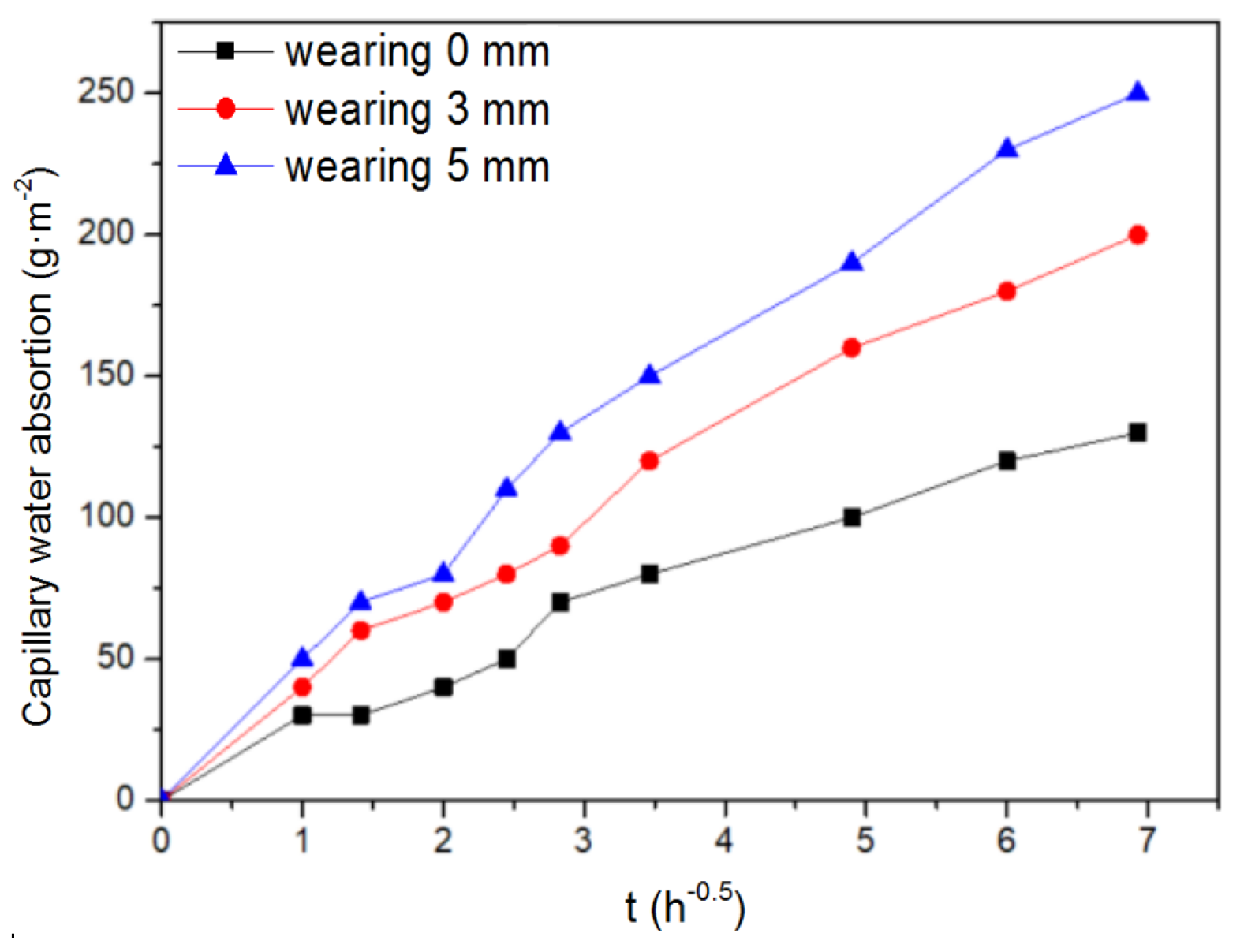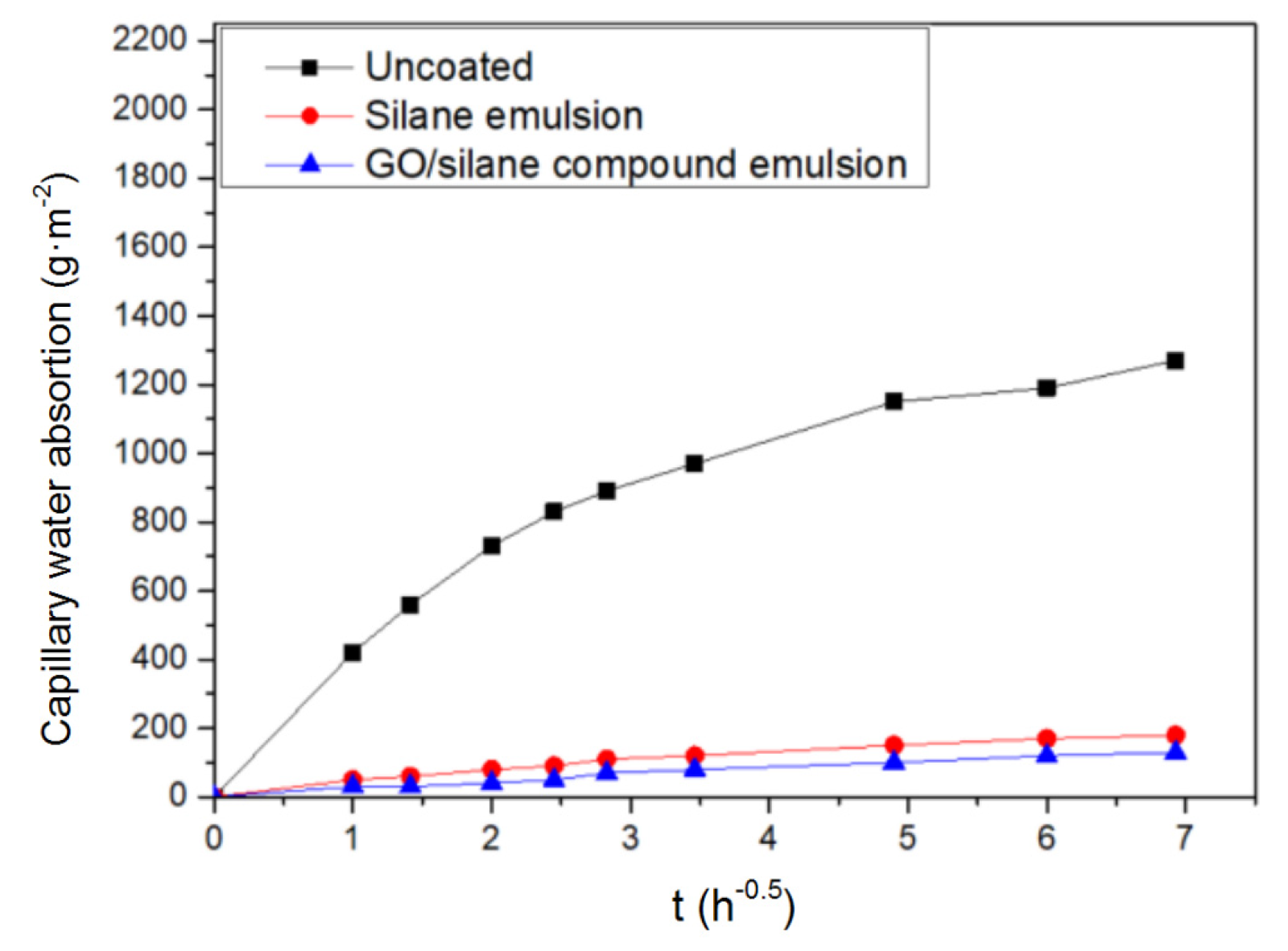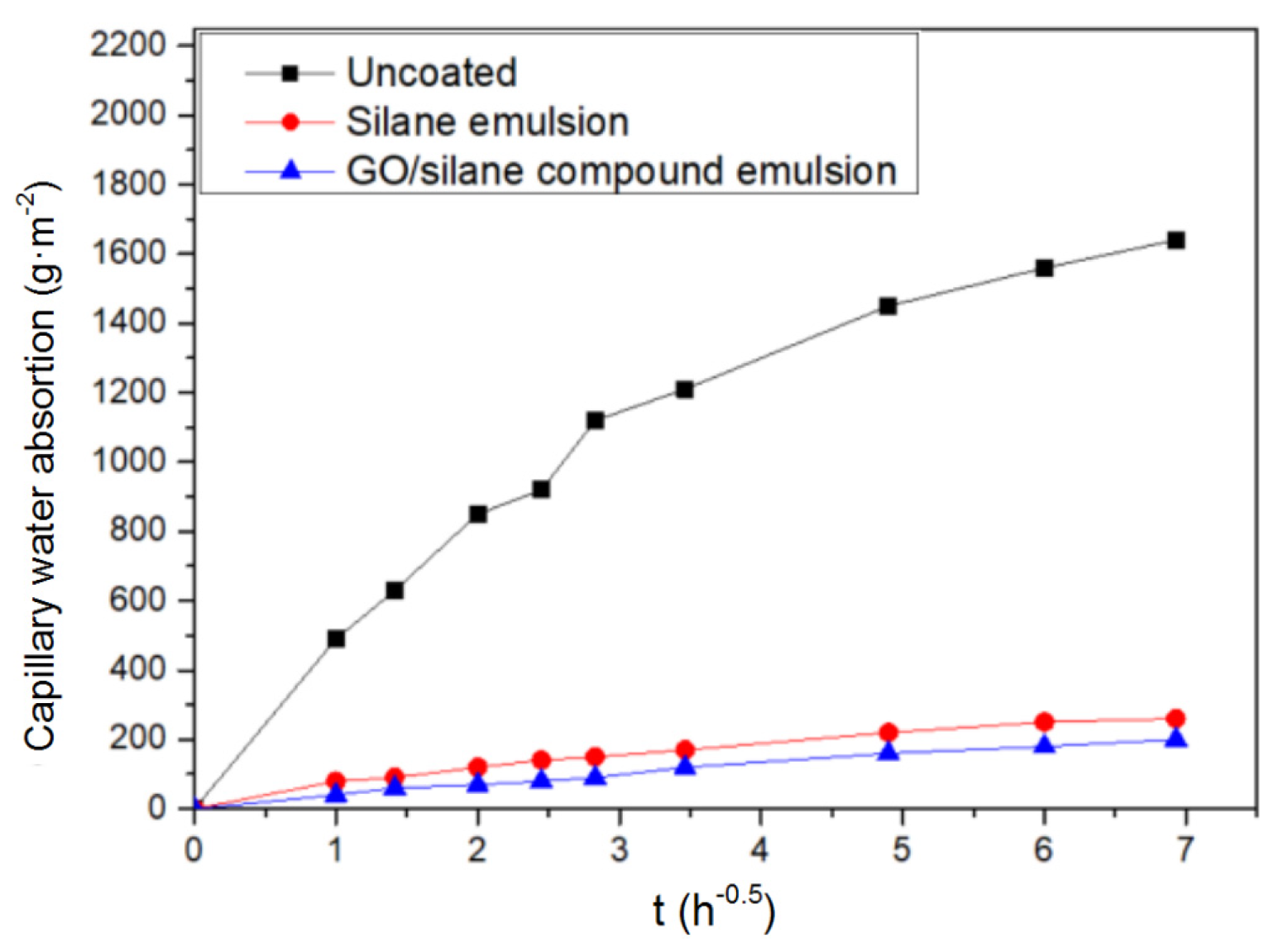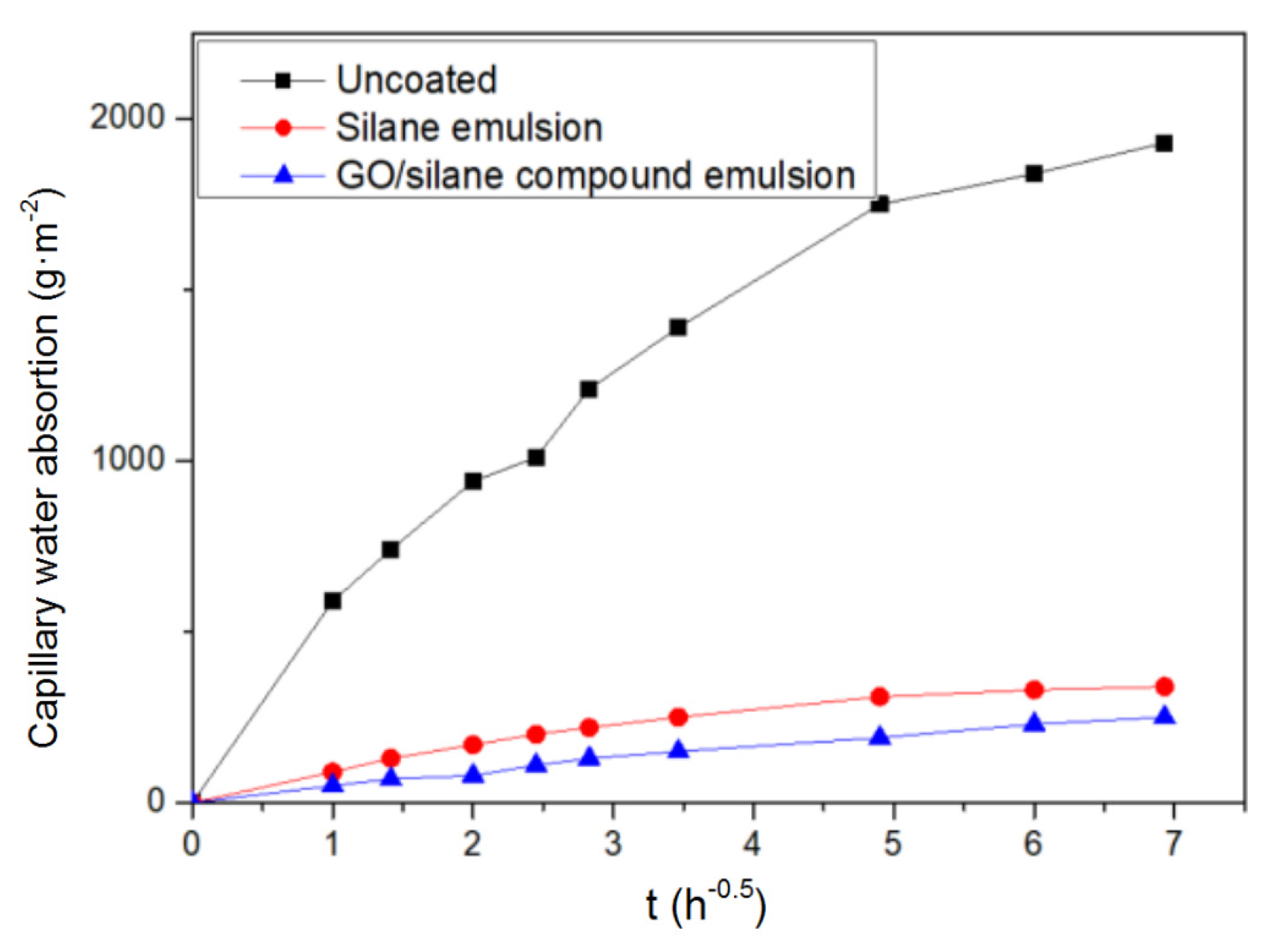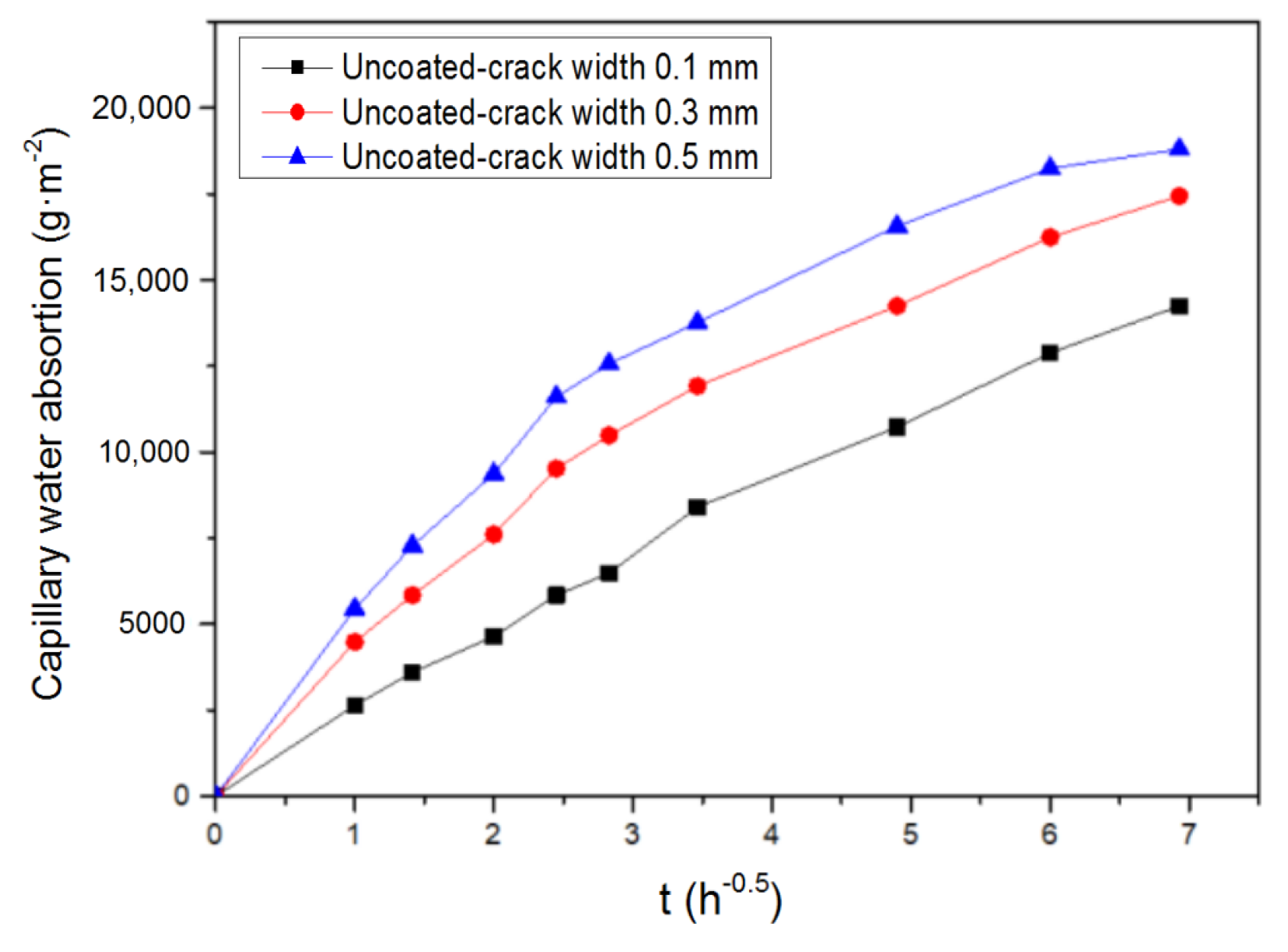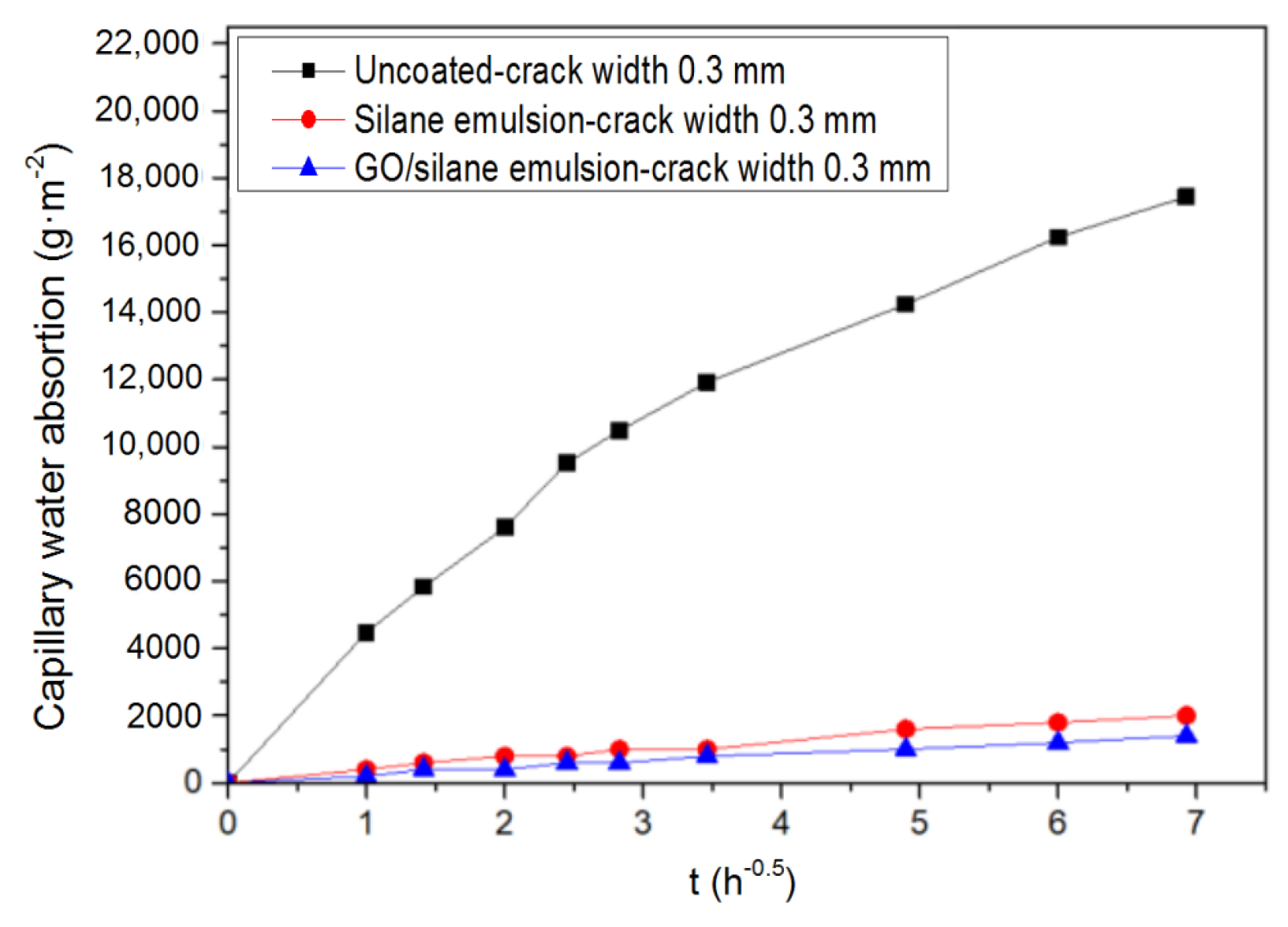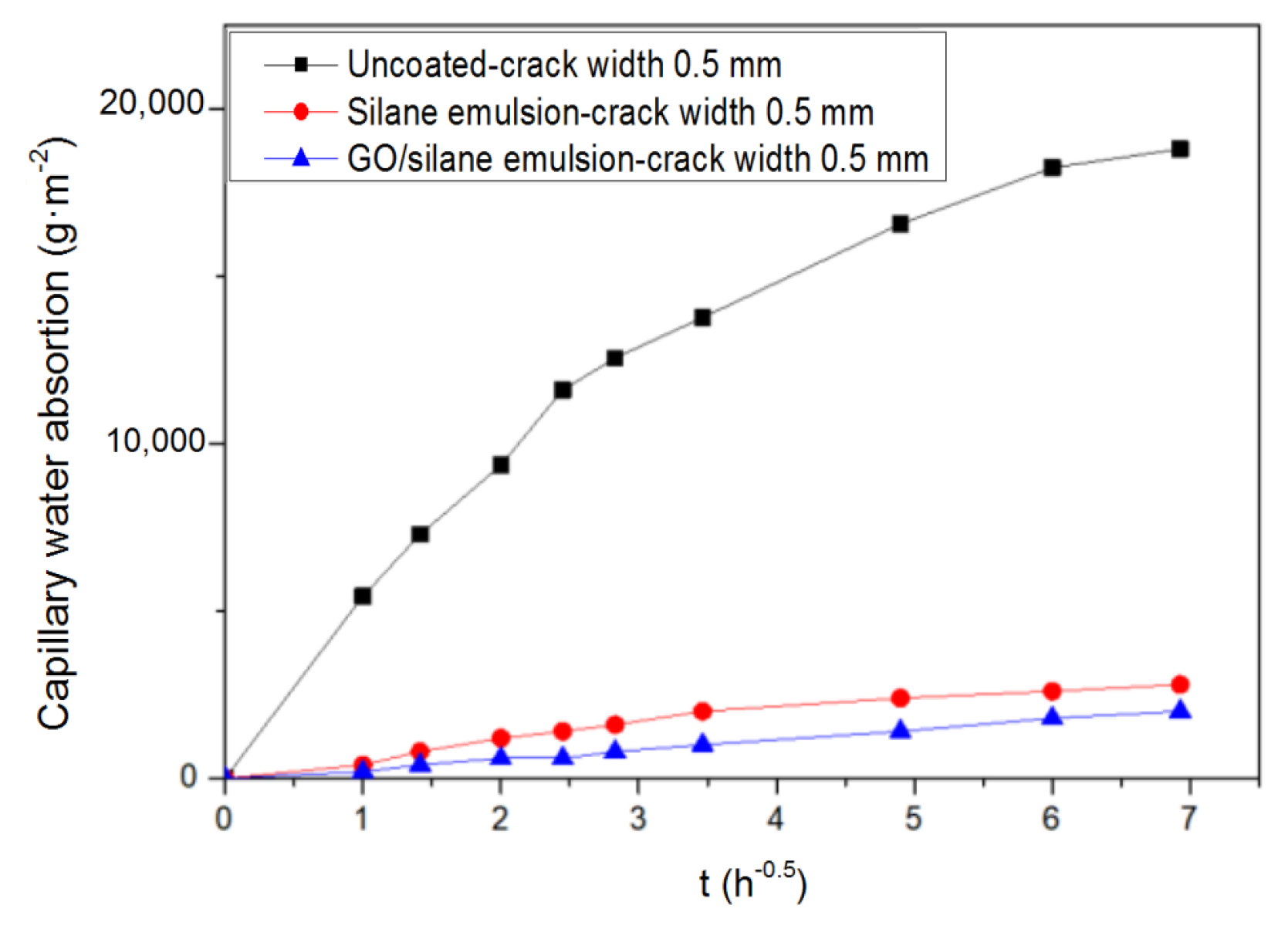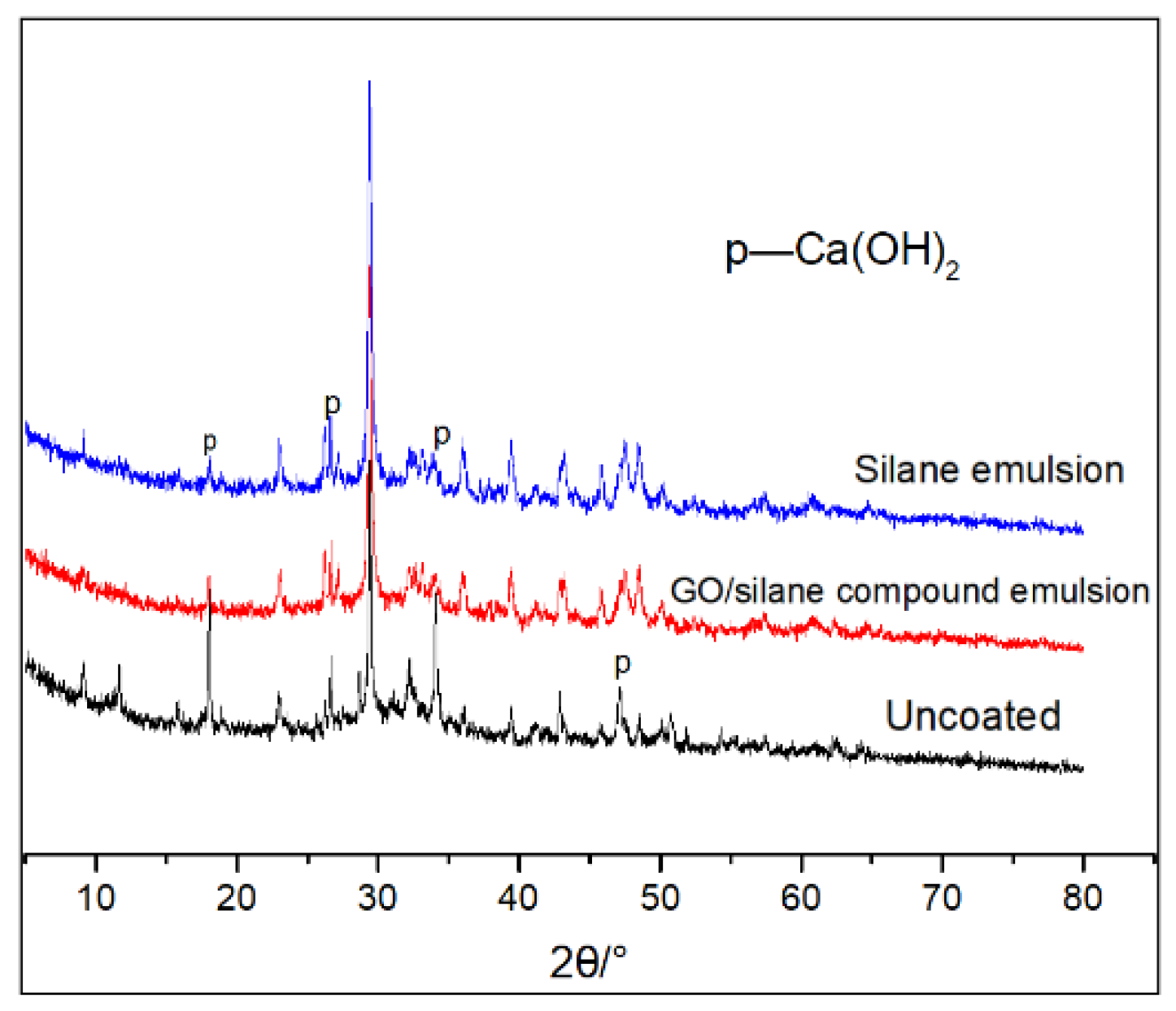1. Introduction
Concrete is the most widely used building material in modern society. Research on the durability of concrete has attracted the attention of various researchers [
1,
2,
3]. With the extension of the service time of the concrete, durability decreases, which leads to the destruction of the concrete structure [
4,
5]. Owing to the different environments in which concrete is used, there are many types of concrete damage, which can be roughly divided into the following: steel corrosion, freeze–thaw damage, chemical erosion, structural cracking [
6,
7], and abrasion damage (ground wear, erosion wear) [
8,
9,
10]. Studies have shown that moisture has a direct or indirect effect on concrete damage. Concrete damage that is not directly related to moisture can also accelerate the transmission of moisture inside the concrete [
11], such as with cracking damage and wear damage.
In view of the damage problems of concrete, such as cracking, spalling, and abrasion, and the waterproof performance of damaged concrete, researchers have studied all kinds of protective concrete coating [
12,
13,
14], including traditional asphalt, such as epoxy resin, polyurethane, and acrylic resin. Practice in construction technology is mainly to besmear a certain thickness of materials on the concrete surface with brushes, filling the concrete pore, and preventing the effect of moisture intrusion; however, these sealing coatings affect the concrete’s breathability, also affecting the development of concrete hydration [
15,
16]. Engineering practice has proved that permeable waterproof material can achieve an excellent waterproofing effect [
17,
18,
19,
20,
21,
22,
23,
24]. A waterproof material can be coated on the surface of the concrete, penetrating into the material, and connecting with the concrete to form a water-repellent layer or reacting with cement-based materials to generate substances that block the pores of the concrete to achieve a waterproof effect. However, coating on the surface of early concrete will affect the hydration of the cement to a certain extent, thereby reducing the hardness of the concrete surface [
25].
As an emerging material, graphene oxide has attracted the attention of researchers due to its special applications and properties. Some studies have found that graphene oxide can compound with cement-based materials to improve their compactness, thereby improving mechanical properties [
26,
27]. However, a direct incorporation of graphene oxide will lead to a sharp decline in the workability of cement-based materials, and graphene oxide can easily agglomerate and is difficult to uniformly disperse in cement-based materials [
28].
In the previous research of this group, a new type of composite waterproof material was synthesized by combining the good hydrophobic effect of silane materials and the effect of graphene oxide to improve the microstructure of concrete surface, and its hydrophobic effect has been verified [
29]. This article continues the previous research to test the waterproof effect of self-developed silane emulsions and composite waterproofing materials on damaged cement-based materials and provides experimental data support for subsequent repairs of actual engineering concrete after damage.
2. Experimental
2.1. Preparation of Cement-Based Materials
This experiment used ordinary Portland cement (PO 42.5), with the chemical composition shown in
Table 4. The concrete used river sand with a fineness of 2.9, the cement mortar used Chinese ISO standard sand, and the concrete aggregate used basalt with a particle size of 5–20 mm. Polycarboxylic acid was used as a water-reducing agent with a water reducing effect of 30%.
According to the mixing ratio shown in
Table 1,
Table 2 and
Table 3, the raw materials, such as aggregate and sand, were weighed. Then, the required cement-based materials were prepared. The preparation of concrete was based on the “Standard for Test Methods of Mechanical Properties of Ordinary Concrete” [
30], the laboratory temperature was 20 ± 5 °C, and the humidity was more than 50%. The preparation was cured under standard conditions (temperature 20 ± 2 °C and the humidity was more than 95%) for 28 days. A sample size of 100 mm × 100 mm × 100 mm was used for the capillary water absorption test of concrete after abrasion. The preparation of the cement mortar test block was based on “Mortar, Concrete Waterproofing Agent” [
31], cured under water conditions (temperature was 20 ± 2 °C). The laboratory temperature was 20 ± 2 °C and the humidity was more than 50%. Its size was 25 mm × 40 mm × 160 mm, and a Φ8 (8 mm in diameter) smooth steel bar was installed inside the mortar test block for capillary water absorption tests of cement mortar with a crack. The cement paste test block was prepared in accordance with “Mortar and Concrete Waterproofing Agent” [
31], cured under water conditions (temperature was 20 ± 2 °C). The laboratory temperature was 20 ± 2 °C and the humidity was more than 50%, with a size of 40 mm × 40 mm × 160 mm, which was used for observation of the micro morphology of cement paste (SEM), and X-ray diffraction (XRD) and comprehensive thermal analysis (TGA) tests.
2.2. Preparation and Coating of Waterproof Material
2.2.1. Preparation of a New Type Graphene Oxide/Silane Compound Emulsion
The preparation methods and related raw materials of graphene oxide (GO)/silane composite waterproof materials have been studied by our group. The main preparation steps are as follows: certain amounts of GO powder and distilled water were weighed and the mixture was put into an ultrasonic bath for vibration to prepare GO dispersion with certain proportions. GO dispersion was utilized to replace distilled water and prepare the GO/silane composite emulsion according to the preparation method for silane emulsion [
29].
2.2.2. Coating Amount of Waterproof Material
The coating amount of silane emulsion and graphene oxide/silane composite emulsion is shown in
Table 5. The most cost-effective coating had been identified in the previous research by our group [
32].
2.3. Penetration Depth Test
The penetration depth test was based on “Mortar, Concrete Waterproofing Agent” [
31]. A 28-day-cured concrete test block was placed in a blast drying oven to a constant weight, and the block was transferred to a laboratory at temperature 20 ± 3 °C and the humidity was above 80%. Then the spraying method was used to waterproof the molding surface. The amount of waterproof material used is shown in
Table 5, with all of the material completely penetrating into the concrete. Afterward, the test block was split along the coated surface, and then the fracture surface was sprayed with water. The white-light depth of the fracture surface was the penetration depth of the waterproof material. Several points were taken to measure the penetration depth, and finally the average value was taken [
33].
2.4. Capillary Water Absorption Test under Different Wear Depth
The capillary water absorption test was based on “Mortar, Concrete Waterproofing Agent” [
31]. A 28-day-cured concrete test block was placed in a blast drying oven to bake to a constant weight, leaving a molding surface and its opposite surface; the other four surfaces were sealed with epoxy resin. The spraying method was used to waterproof the molding surface. The amount of waterproof material used is shown in
Table 5. After the waterproof material completely penetrated into the concrete, the capillary water absorption test was conducted: the laboratory temperature was 20 ± 3 °C and the humidity was more than 80%; the capillary water absorption of the concrete was measured at 0, 1, 2, 4, 6, 8, 12, 24, 36 and 48 h. Then, the test block was taken out and placed in a blast drying box for drying. A mill was used to grind off the coated surface by 3 mm, epoxy resin was used to repair the damaged parts around, and then capillary water absorption on the worn concrete was again tested at different time points. The above steps were repeated to measure the capillary water absorption of the concrete at different time points after a 5 mm abrasion. Finally, the capillary water absorption coefficient of the different groups test block was calculated to Equation (1), and the 48 h water absorption ratio of the different groups test block was calculated to Equation (2):
where
A is the capillary water absorption coefficient (g·m
−2·h
−1/2); Δ
W is the water absorption of the test block within
t (g·m
−2); and
t is the capillary water absorption time (h).
where
R is the water absorption ratio between tested mortar and reference mortar (%);
Wtm is the water absorption of mortar under test (g); and
Wrm is the water absorption of mortar under reference (g).
2.5. Capillary Water Absorption Test of Cement Mortar Test Block with Crack Damage
This test mainly simulates the waterproof condition of the concrete after the cracks appear in the concrete after the waterproof material treatment in the actual project.
The capillary water absorption test was based on “Mortar, Concrete Waterproofing Agent” [
31]. The cured cement mortar test block was dried and transferred to a laboratory, where the temperature was 20 ± 3 °C and the humidity was above 80%. Then, the molding surface, with a size of 25 mm × 160 mm, was used for coating, and cracks were induced after the emulsion was completely absorbed. The induced crack test was conducted with a concrete flexural testing machine (the maximum force value was 1000 kN), with the method shown in
Figure 1. The opposite side of the coated surface was used as the loading surface, wherein the coated surface was facing down and was loaded at a loading speed of 0.1 m/min until cracks appeared; then, a crack width gauge was used to measure the width of the cracks. If the width was not sufficient, the sample was further loaded until cracks appeared. The induced cracks required for this test were approximately 0.1, 0.3, and 0.5 mm, as shown in
Figure 2. This test only studied the water absorption of one crack, so only one crack and its surrounding water-absorbing surface with a size of 20 mm × 25 mm were taken, and the rest was sealed with epoxy resin. Finally, a water absorption test was performed to measure the water absorption at different time points.
2.6. Observation of the Micro Morphology of Cement Paste (SEM)
The cement paste test block, which had been cured for 28 days, was placed in an oven for drying. Then, a molding surface was taken and coated with waterproof material. After the waterproof material was completely absorbed by the cement paste, a small test block with a diameter of 5–10 mm under the coated surface was used. Water mist was sprayed on the surface of the small test block, which had not darkened in color, and was then dried as a sample for SEM.
2.7. X-ray Diffraction (XRD) Test
The 28-day-cured cement paste test block was placed in an oven for drying. A molded surface was then coated with waterproof material. After the waterproof material was completely absorbed by the cement paste, the surface powder of the coated surface was then ground through a 0.04 mm sieve. X-ray diffraction analyzer (Bruker D8, Bruker, Karlsruhe, Germany) was used to analyze the mineral composition of the sample via XRD with a Cu target, a voltage of 3 kW, a scanning range of 5°–80°, and a scanning speed of 5°/min.
2.8. Comprehensive Thermal Analysis (TGA) Test
The surface powder of the coated surface, prepared the same way as above, was then ground through a 0.04 mm fine screen. TGA tests were then conducted. The heat loss of Ca(OH)2 of the sample at 0–1300 °C was analyzed using an SDTQ600 integrated thermal analyzer from the TA Company (New Castle, DE, USA). The gas atmosphere was nitrogen with a purity of 99.99%, and the heating rate was 10 °C/min.
4. Conclusions
The penetration depth of silane emulsion and composite emulsion can reach 5–10 mm, which has a good waterproof effect.
The capillary water absorption coefficient of concrete coated with composite emulsion is 35 g·m−2·h−1/2, which is 75.7% lower than that of concrete without waterproof material treatment with an abrasion of 0 mm, indicating that when concrete is damaged by abrasion, the composite emulsion still has a good waterproof performance.
With a crack width of 0.5 mm, the capillary water absorption coefficient of the cement mortar test block coated with composite emulsion is 91.4% lower than that of the blank group, and the capillary water absorption coefficient of the cement mortar test block coated with silane emulsion is 86.1% lower than that of the blank group. The data show that for cement mortar test blocks with cracks, the silane emulsion and composite emulsion have excellent waterproof performance, and the waterproof performance of composite emulsion is better than that of silane emulsion.
Through SEM, XRD, and TGA tests, it was found that the composite emulsion can form a hydrophobic layer with a certain thickness inside the cement-based material, thereby achieving a good waterproof effect.



